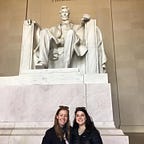Q&A: Sky Dylan-Robbins, Video Journalist at NBC Left Field and Founder & Executive Director of The Video Consortium
This week, we learned how working in video at a magazine and a tech company — and later a broadcaster — drove our Spotlight to create a community for visual storytellers.
The Idea: Can you give us a brief overview of your role at NBC Left Field and NBC News?
SDR: I’m a video journalist, so I produce short documentaries about an array of subjects, from Japan’s nuclear missile drills to the West’s wild horse crisis to ham radio subculture in Hawaii. Getting to travel a lot is really thrilling, and staying with a story from idea to completion (I develop/report/shoot/edit my pieces) is something I really love. We launched late last summer, as an experimental video unit under the umbrella of NBC News, and I was brought aboard right before the launch, after four years at The New Yorker magazine, where I was its Senior Producer, Video.
How does the “experimental” nature of Left Field differentiate your role from more traditional producing work?
Coming to this team meant both building upon and switching up those indispensable (but yes, traditional) reporting/storytelling skills I’m grateful to have honed at The New Yorker. So, for example, I went to Tokyo to report on Japan’s Hikikomori, or “shut-ins,” and we would have made a very different piece if this were for another outlet. Here, we looked for an off-beat, more creative way to show how isolated these people feel, and ended up using a green screen suit to illustrate it.
You also founded The Video Consortium in 2015 and currently lead it. Can you tell us what it is, and how you came with the idea?
The Video Consortium’s a 501(c)3 creative community of today’s leading video journalists and nonfiction filmmakers. We’ve got chapters in New York, Los Angeles, the San Francisco/Bay Area, and Washington, DC. It’s made up of both staff journalists who work at the top publications as well as superb independent filmmakers and video creators. The community comes together online, in a private forum, and in person, at gatherings every month in each city, where we screen work, eat, drink, and talk about the industry. There are also workshops, online resources, and more. A good deal of the nonfiction content and short docs you watch in your social feeds, and online in general, is made by VC members.
Before The New Yorker, I worked at tumblr, as the lone editorial producer, surrounded by engineers (who were, of course, wonderful). Then, when I came to the magazine, there were just a handful of us video folks amidst a sea of writers. A good story is a good story, no matter the medium, but I wanted to meet more video people and talk about where the industry was going, since we’re the ones who’re creating it. So, three years ago, I invited a handful of friends (from the New York Times, Vox, Mic, and a couple others) to come hang out in the back of a little bar in the East Village in Manhattan and talk about where video was going. We did it again the next month, they invited their friends, and the next month we added a screening component, and so on. It’s grown in a really unexpected and exciting way since then, and in New York, for example, we have to cap our gathering attendance at 150 people each month, and pretty consistently sell out. Getting to know the brilliant people in the community is inspiring, and what the VC’s become (and is still becoming!) is pretty special and magical.
What’s a cool project that you’ve worked on recently? Is there anything you’ve learned (or hope to learn) from it?
I’ve had moments when, amidst the craziness and business of life, the thought of literally dropping everything, throwing away my phone, deleting all of my online accounts, and moving to the middle of the woods for the rest of my life has sounded quite enticing. I’ve talked to friends about their feeling this, too, and decided to investigate. I ended up spending time with some folks I found who left everything and live in the woods in North Carolina. There was no cell service or electricity, and I brought a ton of extra batteries for my camera (and a sleeping bag). It was enlightening, and coming back to the city really rejiggered my feelings about what truly matters. The piece got a lot of views, perhaps because it hit home with a lot of similarly overwhelmed people. Our lives are so intense these days! But — what I learned? I don’t want to abandon this world of technology and lots of work anytime soon. It made me quite grateful.
What’s the most interesting thing that you’ve seen from a media outlet other than your own?
This New York Times short documentary about New York’s subway system was so innovative and stellar.
This Spotlight was originally published in the February 20th issue of The Idea. For more Q&As with inside intel like this, subscribe to The Idea, Atlantic Media’s weekly newsletter covering the latest trends and innovations in media.
